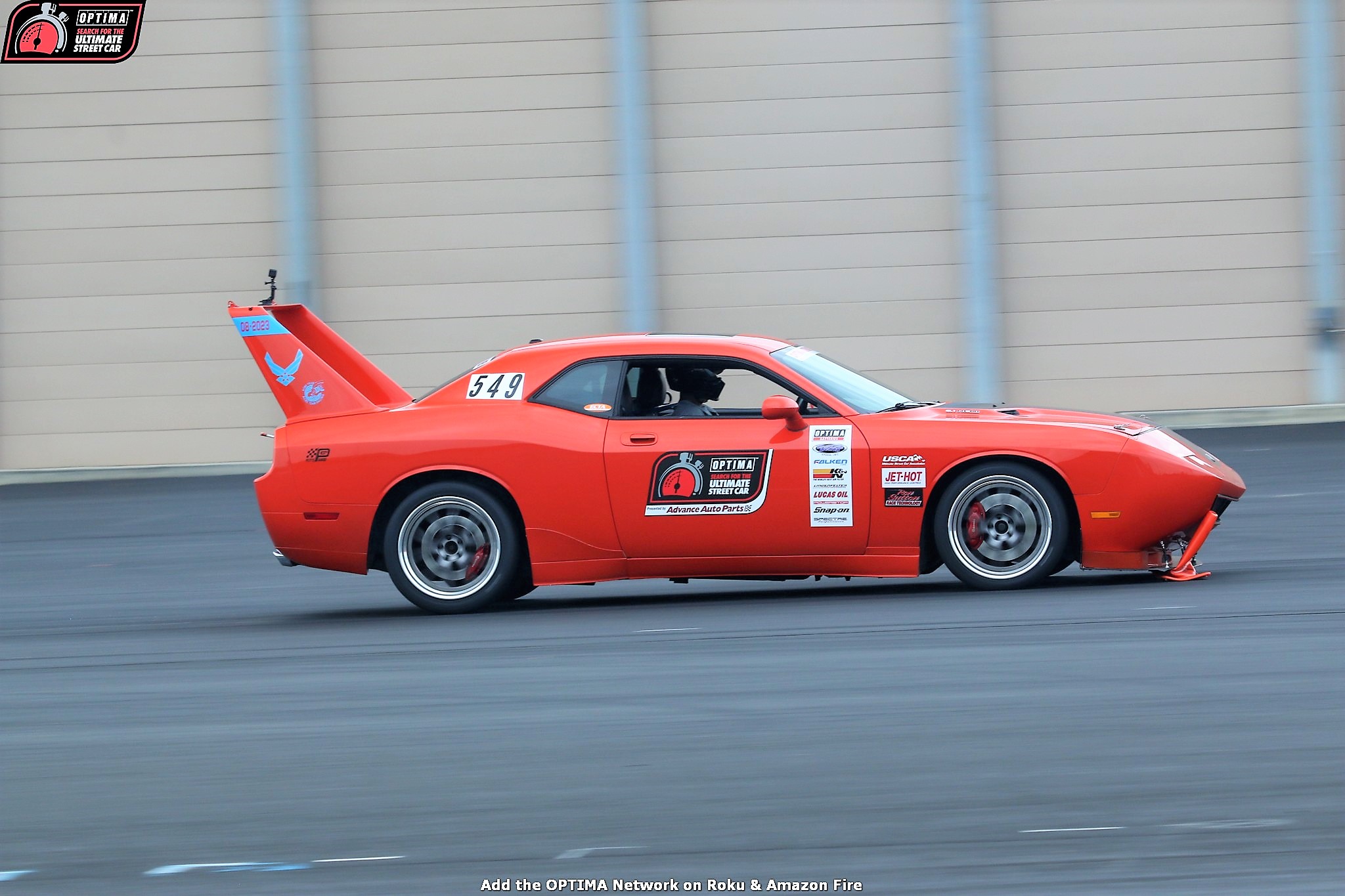Dodge Challenger Battery Life

- Sponsor
- OPTIMA Batteries
- Location
- Glendale, Wisconsin


Vanishing Point is a movie almost synonymous with the Dodge Challenger, as it featured a white 1970 Dodge Challenger. The Challenger was initially produced for only five model years (1970-1974), before it vanished from production. Those early Challengers had a wide array of engine options (at least in the early years), but the battery choices remained fairly constant between Group 25 or Group 34 batteries. If your Challenger is stock, the REDTOP options will work fine. If it has been modified from an electrical standpoint, like an aftermarket stereo or car alarm or a drag car with no alternator, then a YELLOWTOP is the better choice.
The Challenger made a brief reappearance from 1979 to 1983, as a badge-engineered Mitsubishi Gallant Lambda, but so few of those are still on the road today or coveted by collectors, they're hardly worth mentioning. If you do happen to own one, the same considerations for REDTOP versus YELLOWTOP are in play, but you do have more fitment options.
The vast majority of Dodge Challengers on the road today are from the third generation, which began in 2008. Those pony cars have also offered a variety of engine options over the years in both V6 and V8 form, but the battery choice remains (as of this writing) just one- the H7, sometimes referred to as the Group 94R. OPTIMA's DH7 YELLOWTOP is a great option for all of those Challengers enough with the fitment information! When are we going to discuss battery lifespan in the Dodge Challenger?!?
Battery Lifespan in the Dodge Challenger
Now that we've briefly covered all the various fitments for the Dodge Challenger over the years, we'll talk battery lifespan and the truth is, this discussion is applicable to batteries used in any generation of Dodge Challenger or quite frankly, any other vehicle. Batteries are consumable items with finite lifespans and they move closer to their ultimate demise every day after they take their first charge.
Conventional automotive advice is that typical car batteries will last between three and five years, but that's a pretty big span. If a car dealer said the price of a Challenger was between $30,000 and $50,000, wouldn't you like them to be more specific before you agree to make a purchase? The truth is, extreme temperatures, both hot and cold, are both really hard on batteries. Extreme heat causes a lot of damage and and then the extreme cold, when it is harder to start an engine, exposes the damage that was often done in the extreme heat.
Auto manufacturers know this and as a result, nearly every Dodge Challenger on the road today will have its battery mounted in the trunk (or essentially in the floor of the trunk). The trunk can probably get really hot on summer days, right? Absolutely, but it's probably no hotter than it would be under the hood, especially if the engine is running and generating all kinds of additional heat. So if you can protect your battery from extremely hot or extremely cold temperatures, it will perform better and last longer. If you live in places like Phoenix or Anchorage, plan accordingly and don't expect to see the longer battery life that people enjoy in more temperate climates.
The more deeply you discharge a battery, the fewer cycles you will get out of it. If you owned the Vanishing Point Challenger with the 440 cubic-inch engine, you could start it all day long with a Group 25 REDTOP battery that weighs in at just under 32 pounds. Fast forward a half century to the 2020 Dodge Challenger with a 3.5-liter V6 and you'll need OPTIMA DH7 YELLOWTOP battery that weighs in at a hefty 60.5 pounds.
So why does a 220 cubic-inch V6 that is 50% smaller than a big block 440 cubic-inch V8 need a YELLOWOP battery that weighs almost 91% more than the REDTOP battery that can start that big V8? It's not about cranking amps or cold cranking amps, as both batteries have those in spades. It has more to do with the depth of discharge we mentioned earlier and the incredible electrical demands of modern vehicles.
From satellite-based navigation & communication systems to Wifi connectivity, huge entertainment centers with lots of speakers and video capability, as well as integrated car alarm systems with remote access, computer-controlled engines, seat memory presets and radio presets, there's no shortage of electrical demands on a modern vehicle. All batteries from all manufacturers have had a hard time keeping up with this increased demand and as a result, the batteries in newer vehicles tend to be much larger and much heavier than those found in the pre-computerized era of production vehicles.
Battery manufacturers used to brag about CCA (cold cranking amps), but as modern vehicle demands have evolved, expect to see a lot of folks pay closer attention to the weight of the battery they are buying. More weight in a battery often represents more reserve capacity (which can translate into more cycle life) and in the case of OPTIMA Batteries, better components. You can probably find H7 batteries for a Dodge Challenger that use recycled lead and tombstone welds to connect cells, but they'll also probably weigh less than 50 pounds. That's a lot less active material and a lot of compromise if you are concerned about the lifespan of your battery.
All OPTIMA Batteries use 99.99% pure virgin lead and thick, cast straps to connect the cells together. It's more expensive, but there are five big reasons why it is better.
-Batteries with recycled lead sulfate faster, which can mean a shorter lifespan
-Batteries with recycled lead can self-discharge faster, which can mean a shorter lifespan
-Batteries with recycled lead can have more impurities, which can lead to more gassing & a shorter lifespan
-OPTIMA's thick, cast straps that connect the cells are more durable than the fragile tombstone welds used in typical batteries, which can mean a longer lifespan
-OPTIMA's thick, cast straps allow for better current flow than more restrictive intercell tombstone welds, which can mean a shorter lifespan
The last point we want to cover on Dodge Challenger battery lifespan is proper voltage maintenance. Fully-charged, our DH7 YELLOWTOP battery will measure about 13.0-13.2 volts. Whenever any lead-acid battery is discharged below 12.4 volts and is left sitting in that state, sulfation will form in the battery plates, which diminishes performance & battery lifespan. Pop the hood (or trunk) on any car in a supermarket parking lot and there's a good chance you'll find a battery that isn't fully-charged.
Vehicles that see daily use tend to also see their batteries last longer, than those that only see seasonal, weekend or occasional use. That isn't always the case, but by and large, batteries in vehicles that are driven on a daily basis tend to be better-maintained. Vehicles that see infrequent use tend not to have the voltage properly-maintained, which shortens battery lifespan, so if you don't daily your Challenger, you should keep it plugged in to maximize battery lifespan.
We are so confident proper battery voltage maintenance can improve the performance & lifespan of your battery, we will extend the free replacement warranty by a full year on your OPTIMA battery, if you buy an OPTIMA Digital 1200 charger from us when you buy your battery. That charger works great on all 12-volt lead-acid batteries, so even if you don't have an OPTIMA battery in your Challenger right now, you can still use the OPTIMA Digital 1200 to maximize the performance and lifespan of the battery you do have today.
